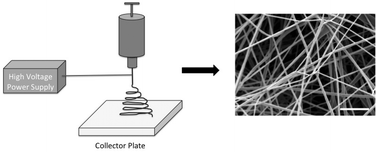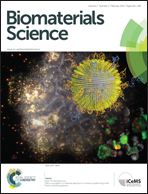The osteoblast and osteoclast responses to phosphonic acid containing poly(ε-caprolactone) electrospun scaffolds
Abstract
We describe a novel polymer containing phosphonic acid moieties which has been shown to increase the osteoblast response and decrease osteoclast activity. A 3D scaffold comprising of poly(ε-caprolactone) (PCL) functionalised with poly(vinyl phosphonic acid-co-acrylic acid) (PVPA-AA) was fabricated using electrospinning. PVPA-AA is hypothesised to mimic the action of bisphosphonates, a group of drugs used to treat osteoporosis, and likely to affect bone turnover by increasing the activity of osteoblasts and reducing osteoclast activity. The expression of collagen type I, osteocalcin and alkaline phosphatase has been found to be significantly higher (p ≤ 0.001) on PCL/PVPA-AA scaffolds when compared to PCL and tissue culture plastic (TCP). In addition, after 21 days there was a significant increase (p ≤ 0.001) in mineralisation on PCL/PVPA-AA substrates. The PCL/PVPA-AA scaffold has been reported to significantly (p ≤ 0.001) decrease osteoclast viability, with comparable results to Alendronate, a commercially available bisphosphonate. For the first time, we describe a novel active synthetic bone graft substitute, which has been shown to increase osteoblast proliferation and matrix deposition as well as reducing the number of osteoclast cells by locally induced apoptosis. The combined affects of the novel PVPA-AA polymer on osteoblasts and osteoclasts may lead to active bone repair and healing.


 Please wait while we load your content...
Please wait while we load your content...